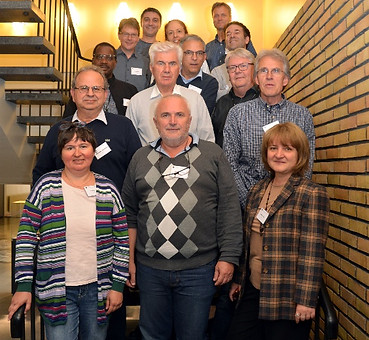Post-Project Community

The EuroLithos project assembly meeting was held in Trondheim, July 3, 2019. Most of the Eurolithos partners were present. The main issues addressed at the meeting were Deliverable 3.1 (Summary of the nature and type of available spatial data in each country partner and the framework for the Atlas), the final structure of ornamental stone directory (WP4: technical properties) and the start-up of several case studies in WP5. On July 4th, the consortium travelled south to the municipality of Oppdal to visit companies that produce schist.


The group before (left) and during fieldtrip – experiencing snow in July. Even for Norwegian standards, this is quite rare!
It’s time for some case studies
Case studies are good tools for shedding light over various aspects of a problem, and they can serve as a basis for creating new guidelines and rules for best practice. So, it’s time for some case studies! Each case study will exhibit a selected Eurolithos theme: 1) Value assessment of quarry landscapes and resources, from historical values (importance to architecture and cultural landscapes) to future values; 2) Connecting stone resources with the use of stone, i.e. tools for geographical and historical information; 3) Intangible values connected to stone resources, i.e. craft traditions and how they are kept alive; 4) Other themes, including sustainable stone production. For the most part, Eurolithos partners will carry out their case studies in collaboration with industry and other institutions.
For example, one case study will focus on the rich stone-built heritage of the Adriatic coast, where local limestone resources are the key to maintaining and preserving heritage, but no raw resources are available for this task, due to other land-use priorities. How should we respond to this challenge? More information about these case studies is coming soon.
Traditional houses built of platy limestone at the Adriatic coast. Should they be abandoned and left to deteriorate? (photo delivered by Matevž Novak)

Schist that can be split along natural cleavage planes into either thick or thin slabs is a common and important stone resource in Norway. One of the most important schist deposits in Norway is located close to the village of Oppdal, Trøndelag county. While schist has been produced in Oppdal for a few centuries, the craft of extracting and splitting schist slabs can be traced back about one thousand years. Today, three companies produce schist for both traditional and innovative applications. The story of schist production in Oppdal suggests that past traditions are an integral to achieving the goal of a sustainable future. The Oppdal Schist is the main building stone of the newly built Norwegian National Museum. Two companies, Oppdal Sten and Minera Skifer, have agreed to participate in a Eurolithos case study.


Left: Breaking the schist slab along a straight line looks like magic but belongs to a very old craft tradition. Right: modern quarry.

Jakob Keiding, past WP2 leader, has left Norway for a new post in Denmark. Thank you, Jakob for your important contribution to EuroLithos.
Anne Liinamaa-Dehls has taken over as WP2 Leader. Since 1997, she has worked with communication and dissemination activities. She has served as Executive Secretary of the Office of Permanent Secretariat of the International Union of Geological Sciences (IUGS) in Trondheim (then Beijing), and is familiar with a broad range of activities and key institutions in the global geological community. Anne will be the main contact point for stakeholders, for web issues and social media.

You may now find information about EuroLithos activities on several online platforms. The GeoEra project website provides you with basic information about this and other GeoEra projects. Or you can go directly to the EuroLithos website. Facebook users please follow our page dedicated to the Eurolithos themes, activities and results. And those who are active on Twitter follow can find the EuroLithos Twitter feed here. We invite all members in the European ornamental stone community to contribute material to help us make these platforms dynamic and join us in promoting activities on this topic.
screen capture www.eurolithos.org
Are you a super-stakeholder?
Some of you have expressed interest of being more involved in the project then just as stakeholders. Thank you for your interest! You might consider participating in case studies, or providing knowledge of critical to completing our Work Packages. If you sign up, please note that we will be calling upon your contribution. Please send your comments to Anne Liinamaa-Dehls mailto:ald@ngu.no
Send us your suggestions for news items
This newsletter was produced by Jakob Keiding and Anne Liinamaa-Dehls, coordinators of communication. Our next newsletter is scheduled for July 2019. Please help to develop and keep this newsletter vibrant by sending all your news and views, meeting announcements, links to recent publications, photos, etc. to Anne Liinamaa-Dehls ald@ngu.no
To be REMOVED or ADDED to the Eurolithos mailing list please contact ald@ngu.no

This project has received funding from the European Union's Horizon 2020 research and innovation programme under grant agreement No 731166
